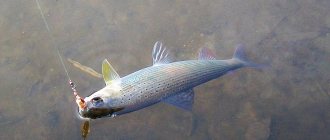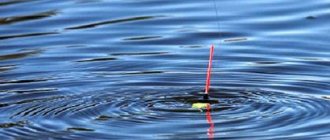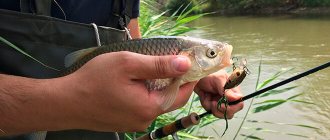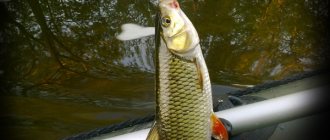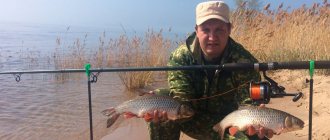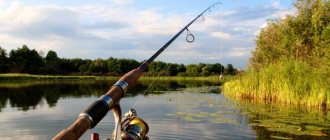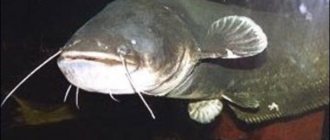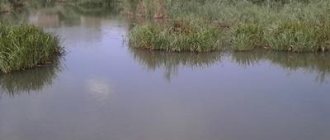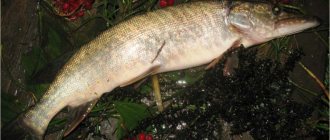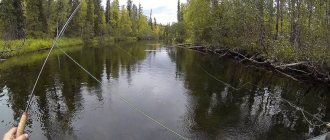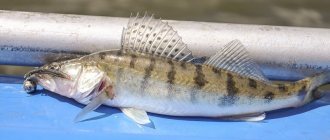Basic principles of fishing in autumn
Catching chub in the fall will give the desired result only with a full understanding of the behavior of the fish during the cold spell, and knowledge of what it begins to feed on.
At the end of August and beginning of September, the chub begins to actively feed, and since the fish is considered “conditionally predatory”, it easily switches from algae and insects to living creatures. The chub got its name because of its overly large head and powerful pharyngeal teeth, and therefore in the fall its prey becomes not only small gudgeon, but also frogs with molted crayfish.
Attention!
The chub is a very cautious fish, constantly monitoring its movements on the shore and in the water. Therefore, it is necessary to catch chub from the shore in the fall so that your shadow does not fall on the surface of the water.
It is better to cast the rod while hiding behind a snag, bush or tree, trying to get to the very depths from where the fish rises in search of prey. Catching chub in the fall should be focused on choosing a fry (bleak or gudgeon) as bait, and for individuals larger than 1 kg - a frog or crayfish. You can also catch a large trophy using a spinning rod, using spinners, wobblers or a tee with red fluffy thread. Read more about spinning fishing here.
Photo 1. Spinning is the most popular tackle for chub.
[custom_ads_shortcode1]
Fishing place
Autumn fishing can be divided into two periods - before and after Indian summer.
Before Indian summer, which usually takes place in September, it is advisable to look for firebrand in summer places - riffles, seething streams, near dams and bridge supports. In such places, small cranks and minnow wobblers and center-loaded spinners still show excellent results.
After the Indian summer, the smut begins to gradually move to deeper places in the reservoir - to the nearest edges, places next to snags, underwater areas of current boundaries and standing water. In such places, the optimal baits will be front-loaded spinners, small oscillating spoons and silicone jigs. The most promising wiring is slow jigging.
Since autumn jig fishing involves the use of heavy baits, and chub imitations are small in size, the use of a retractable leash when fishing in the depths is considered absolutely justified.
Photo 3. All predators love to hunt in thickets of vegetation.
Just as in the summer, in the fall the smut begins its hunt not in the morning, but when the water has warmed up a little under the rays of the sun. Approximately smut fishing begins at 10-11 am. The chub prefers sunny days, and if the weather is rainy and windy, then you may not get a bite on such a day.
September fishing
Chub fishing in September is focused on using a variety of gear and bait. In the fall, ordinary zakidushki, postavushki and donki in various variations are popular. It is mainly used by fishermen on large rivers with fast currents. The choice of this fishing method is based on changes in fish behavior associated with colder water.
September is the last month in which you can still use a float rod for fishing by lowering the hook with bait to a depth of 1.5 meters or more. If the weather is warm, you can put a caterpillar or worm on the hook as bait, but at the end of the month you won’t be able to catch a chub without small and active fish.
[custom_ads_shortcode3]
Bait
The chub lives in rivers with clean, cold water. The fish are not afraid of the fast current. The bottom of the reservoir should be rocky and pebbly, with a large number of riffles. In these conditions, fishing with a rod and float is focused on traditional bait.
For those who do not know what to use to catch a chub using a regular fishing rod, it is important to understand that the larger the fish, the wiser and more experienced it is, so you can only seduce it with food that is familiar to it. Among live baits, these can be traditional options:
- worms;
- bloodworms;
- maggots;
- small fish;
- cervical cancer;
- dough with “meat” additives.
What to fish for in October
Chub fishing in October will be successful and bring good luck if you start using small minnows attached to a tee as bait. It is very important that when biting the fish swallows at least one of the hooks. Experienced fishermen and experts in autumn chub hunting recommend in this case choosing a tee No. 5 for the tackle, and as a safety net, tying a single hook No. 5 onto the fishing line. The tee is inserted under the dorsal fin of the fry, and a single hook is passed under the lower lip.
Photo 2. Minnow as a chub fish.
In the first two months of autumn (September and October), if they have warm and stable weather, you can catch chub on a spinning rod, using spinners or wobblers. It is important to remember that the chub goes to depth in the fall, and therefore the supply of fishing line on a spinning rod should be at least 45-50 meters. A small frog is placed on the hook, pulling the bait to a distance of no more than 20-25 cm from the sinker.
[custom_ads_shortcode1]
Chub behavior in autumn
In autumn, it is better to catch this fish in the afternoon, when the river water is warmer from the sun. But in the evening, the temperature of the air and the river drops, and there may not be a catch, since the chub loses its activity and interest in the food on the hook. That's why you shouldn't go fishing early in the morning and in the evening. At night you will also not get a bite. Exceptions can be made for areas with warm autumns and Indian summers. It is on such warm days that there is a high probability of catching a large specimen at night. The fact is that a large, “seasoned” chub prefers to feed at night, swimming out into shallow water in search of food.
He will quickly bite on odorous bait of animal origin. When cold weather occurs after the summer period, the chub prefers meat baits rather than bugs and worms. He begins to have an autumn glutton to gain weight before the cold weather. This period usually lasts throughout September and part of October.
To catch chub, you should choose calm, clear weather, since in rainy weather the fish go to the bottom and also reduce activity . When there is a strong autumn cold snap, the big-headed fish loses its appetite and sinks to the river bottom. During this period, the chub gathers in schools, and if you find one, you will be guaranteed good fishing. That’s why, after catching the first fish, you shouldn’t leave the spot, but cast your fishing rod again.
Did you know? The chub is omnivorous and voracious.
This fish, like all representatives of the carp family, does not have a stomach. As a result of this, food is not completely digested, and the chub is constantly looking for new food.
November fishing
Chub fishing in November is possible only on sunny, windless days and during the thaw period, when the air temperature rises above 10C. In such weather, the fish begin to feed no earlier than 10 o’clock in the morning, so it simply doesn’t make sense to cast the tackle earlier.
Attention!
The chub does not feed for long in November - about 2-3 hours in the morning, and the same amount in the afternoon. The activity of fish is affected by cooling air and water, and chub biting almost completely stops when the air temperature drops to 0C and frost sets in.
It is incorrect to say that chub do not bite at all in late autumn. If the reservoir is not covered with ice, and the weather is calm and sunny, fish can be caught even in the winter months. The main thing is to choose the appropriate gear for the weather and the reservoir and correctly determine what to fish with.
Chub fishing in late autumn is most often carried out using gear such as a donka. At the same time, it is very important to understand that you can wait a very long time for a bite, and therefore you need to be patient. For fishing in large reservoirs and small rivers, the following types and designs of donks are used:
In the southern regions, chub are very often caught on a bottom with a feeder, when the fish are lured to the hook with flavored plant components (oils or cake). When choosing this gear, be guided by weather conditions. When cold weather sets in, when the chub gorge becomes active, the fish simply stops paying attention to additional bait.
In autumn chub fishing, strong fishing rods are often used, the length of which depends on whether you are fishing from a boat or from the shore. In any case, it is necessary to carefully study the bottom of the reservoir in order to throw the sinker with the hook and bait as deep as possible, and, based on this, choose the optimal length of the fishing line. In addition, pay attention to the choice of float - it should not be too long and bright so as not to scare away cautious fish.
In late autumn, in bright and sunny weather, chub can also bite on a spinning rod. Small (00, 0, 1 or 2) sized spinners are selected as bait. If the river is wide and deep enough, then in October and November you can use jig baits no larger than 4 cm in size.
Vibrotail and twister of natural, dim colors have proven themselves well in autumn chub fishing. You need to start casting with them, and if smooth casting does not produce results for a long time, gradually change them to brighter ones (green and yellow).
During active feeding, fish may be attracted by a rotating spoon with a noise effect. There are many debates about the use of such bait, but the undeniable fact is that chub actually react more often to such lures during the autumn feeding period.
Autumn fishing for chub is very similar to hunting for large perch. When fishing with a spinner, the retrieve is performed very slowly, without jerking or long stops. Be sure to pay attention to ensure that the spoon or wobbler is in stable working condition, constantly rotating and vibrating in the water.
To catch fish you will need some skills and enormous patience. Even the smallest specimens can behave quite actively, not giving up their positions for a long time. Under no circumstances should you fish for a trophy with fishing line, use only a reel.
It is necessary to remove the fish from the water by slightly moving the chub away from the place where it was caught, so as not to scare away other fish. Don't delay fishing. The process should go smoothly but quickly, gradually moving the catch towards the landing net.
Remember that autumn chub fishing will become interesting and enjoyable only when you are fully prepared for it, stocking up with everything you need. Carefully study the behavior of fish in a given body of water, try several types of bait and bait, and remember that in the fall the behavior of the chub depends only on changes in weather conditions!
The best time for such fishing is a sunny October day. It’s not worth getting up early in the morning and rushing to go fishing in October. Since the chub begins to peck only closer to lunch. Winged insects are difficult to find and catch at this time due to night frosts, so it is better to use a simple worm as bait.
You should look for chub in quiet places under the shore without strong currents. Well warmed by the sun. Usually such places are teeming with peaceful fish, which swim imposingly on top and bask in the last autumn rays of the sun. This picture can be observed on reservoirs with a high steep bank, being 2-3 meters above the river, when the sun shines through the upper layers of the water.
It was there that the chub hid a little deeper. How to force him to appear on the surface? It is enough to throw a small piece of worm into the water. It is very good if you are above the river level. Thus, you can not blindly, but by observing, decide whether it is worth spending your time on the local inhabitant. Are you satisfied with its size or is it better to move on?
It should be noted that the ubiquitous little things floating on top will also attack anything you throw into the water. To catch a chub, you should use thin fishing line 0.1-0.2 mm, a hook with a long shank is desirable, its size depends on the size of the bait, in this case the size of the worm, and the fish you want to catch.
A mandatory attribute for catching chub will be a foam ball on the shank of the hook closer to the eye; the attached worm should in no way sink to depth, but be on the surface of the river. By moving, attract attention and force the chub to attack.
Petr Flyagin Specially for Samodelkifish, Sverdlovsk region, Russia
- Catching autumn burbot
- Grayling fishing in October
The chub is a freshwater representative of carp fish. It deserves its name because of its thick and wide head. It feeds on algae, larvae, mollusks, worms, and small fish.
One of the effective ways to catch chub is using a spinning rod. In autumn, the chub’s diet changes, which causes a change in its preferences regarding habitats and methods of prey.
With the onset of September coolness, the chub moves to significant depths. At the same time, there is a drop in fish activity. The best time to catch chub is in good clear weather.
In September, the greatest activity of chub is observed in the morning after 9–10 o’clock, when the sun warms up the water better.
To catch chub, you need a spinning reel with a friction brake. The chub is a very strong fish, you will understand this even after biting a specimen of several hundred grams. Since fishing is carried out with small wobblers and spinners, monofilament fishing line can also be used. But it is advisable to use a fluorocarbon leash 1-1.5 meters long.
In October, the main habitats of the chub are various bottom depressions. You can also often find fish under bushes and trees hanging over the water. The greatest activity of chub in October is observed closer to noon.
It is better to use spinners as bait. The spoon should be small in size (maximum size 2, usually 00, 0, 1), but quite heavy. The use of a wobbler with greater depth also gives good results. At the same time, baiting should be carried out more in the coastal zone!
[custom_ads_shortcode2]
Where to catch chub
The best places for catching chub are areas near steep banks with deep and calm water.
Good results are obtained by fishing for chub in holes under rifts, where the predator behaves less cautiously, and its bites are particularly powerful. The riffle can reach the rifts themselves only during the daytime, and only if the depth at the rifts is at least a meter.
The areas in the water discharge area and the pits underneath are open all-season. There is always a lot of food here, and the water is saturated with oxygen. If the discharge is intense enough, the flow of water “digs” a deep hole in which various predators coexist. There is a lot of whitefish under the spillway, and where there is a lot of it, there are a lot of predators. Everything is logical.
Spinning chub fishing in November
Wobblers for autumn chub should be less than 5 cm in length and have a natural color. In November, the chub spends most of its time at a considerable depth. Activity begins to show in the afternoon.
Since it becomes much more difficult to get chub in the coastal zone, jig baits are often used. But their size should still be small (maximum 4 cm in length). Twister or vibrotail - it doesn’t really matter.
But it’s better to start fishing with dark or natural colors. If there is no bite, it can be assumed that it is difficult for the fish to see the bait - then try a red, yellow or green color (possibly a fluorescent tint). Such bright colors are usually used for fishing in the dark or in muddy water.
[custom_ads_shortcode3]
Chub in September on a spinning rod
In September, it is convenient to catch chub using a spinning rod from a boat or from the shore. All elements of the gear must be designed to combat fiercely resisting fish. A spinning rod is selected based on the need to cast the appropriate bait.
Considering that chub can be found in different horizons throughout September, it is important to select the appropriate equipment:
• At the beginning of the month, when the predator is actively hunting for insects that have fallen into the water, it is advisable to use floating wobblers or appropriate artificial flies. Fishing is carried out by floating bait or retrieving it in the upper layer of water. Casting (rafting) on warm September days should be done under coastal vegetation hanging over the water;
• On the cold days of the first month of autumn, the chub rarely rises to the surface, but it does not stop feeding. During such periods, jig or bombard fishing is successfully used. The main thing is that the equipment and bait allow you to carry out wiring into the water floor without any problems. Slow-sinking wobblers, silicone baits and light spinners are used. When using a bombard with appropriate buoyancy, you can use any bait available in your arsenal. You can make a bombard yourself without any problems;
• A stable decrease in temperature in September forces the chub to look for food in the bottom layer of water. On such days, a Tyrolean stick is used. Its use allows you to conduct baits with high buoyancy above the bottom surface.
When catching chub in September using a spinning rod, it is important to remember that this predator is very careful, so the elements of camouflage should not be neglected. In addition, you should be prepared for long journeys in search of chub. But usually no one is left without a catch.
Selection of spinning baits for chub
The most effective are rotating spoons , which attract the attention of active chub with the noise they create.
When using a spoon on small rivers, use a smaller spoon than on large rivers. In addition, various spinners make it possible to make long casts and work at various, including great depths.
The presence of a wide variety of wobblers makes it possible to optimally select baits that are effectively used when catching chub. In terms of size, the most successful are wobblers with a length of 35 to 65 mm, weighing 3–7 g. In this case, surface and sinking wobblers give good results. However, you need to remember that in each specific situation it is best to choose a successful wobbler through experimentation.
As practice shows, chub prefer dark-colored bait - black or brown. If you don’t have such baits in your arsenal, a black permanent marker can help.
Jig baits (twisters, vibrotails) are also used when catching autumn chub, mainly in late October and November, when the fish goes deeper. Wiring, in this case, must be stepped, and you need to experiment with the length and speed of wiring. The more passive the fish, the slower and calmer the retrieve should be.
None Which fishing line should you choose for spinning fishing? Fluorocarbon, braided or monofilament - a detailed description of the advantages of each type of fishing line.
Tying lures with a knotless clasp is a very convenient method.
[custom_ads_shortcode1]
Autumn feeding migrations of chub
During periods of significant cooling of the water, the chub spends less and less time in the fast current. Staying on fast waters in cold water requires significant energy expenditure; At the same time, in the fall it becomes more and more difficult for fish to find food, and this forces them to stay for a long time at a comfortable depth and comfortable current. For the chub, these are deep riffles, reaches and holes with a depth of 2.5–5 m. However, even during cold spells, the chub usually stays close to the coastal or island zone, since there are areas with lulls in the flow, with strips of algae that retain their freshness for a long time in the saturated conditions. oxygen in water, with water barriers, with silt deposits and various irregularities at the bottom. All this has a beneficial effect on the food supply, and, as you know, any fish gravitates towards areas where food is concentrated.
During the cold period of autumn, local feeding migrations can be traced among the chub, when it comes out from quiet zones along a certain route to feed on the waterways on which the fry are kept or which wash out living food organisms from silt, algae, and submerged branches of bushes (trees). Knowing these trails, you can go fishing quite purposefully. For example, in one place on the Upa in the fall, a large chub stays in the area of the bridge, below which there is an island washed up by the current and completely overgrown with aquatic vegetation (water lilies, sedge, arrowhead). There are deep channels on both sides between the island and the shores. The chub stays at the end of these channels, where the depth is about 4 m and the current is weakened, but its feeding route runs clearly along the edge of the strip of coastal algae, which is quite long and approaches the waterways near the bridge. This route has been tested more than once, as decent-sized specimens are regularly pecked on it. The most convenient way of fishing here is on a half-bottom with a long leash. In a similar way, it was possible to catch chub on Lopasnya.
I often used steamed wheat grains as bait for chub in September. In general, this attachment is a priority for many types of carp fish. In the autumn, on medium and large rivers, together with chub, they often take large roach, bream, silver bream, ide, blue bream, podust, and sometimes carp and carp.
On shallow but fairly wide rivers, where the depth of holes rarely exceeds 3–4 m, chub can leave their permanent camp sites to hunt for rocky rifts. Here he waits for a fry that has strayed from the flock or fallen in a strong current, or some other food, because the chub is essentially omnivorous. I happened to fish in the fall on the Tvertsa River, a tributary of the Volga, and the bites of measured chubs usually occurred on the riffles in those places where there were the largest boulders hidden under the water. The chub stood behind the barrier and literally pounced on the bait floating near the bottom close to the stone. Also catchy were the areas where the riffle turned into a small hole. The chub could stand at a depth in front of the drop, and the bite would follow as soon as the bait dropped to a greater depth when fishing from a shallower depth. For this fishing method, it was necessary to use a leash 40–60 cm long. Then, when moving the sinker near the ground, the nozzle dragged along the bottom; when the rig began to go over the hole, the leash fell through, and the bait fell seductively down, attracting the attention of the fish. Similar areas of the bottom are found near dams.
Fishing gear
A spinning set “tailored” for chub is not cheap. It includes:
- a fairly strong and at the same time light rod, close to ultralight;
- inertia-free reel with smooth running and good laying quality;
- the thinnest but strongest fishing line that can withstand the resistance of hooked fish;
- miniature baits weighing no more than 5 g (usually spinners No0, No1 and wobblers from 2 to 4 cm long).
